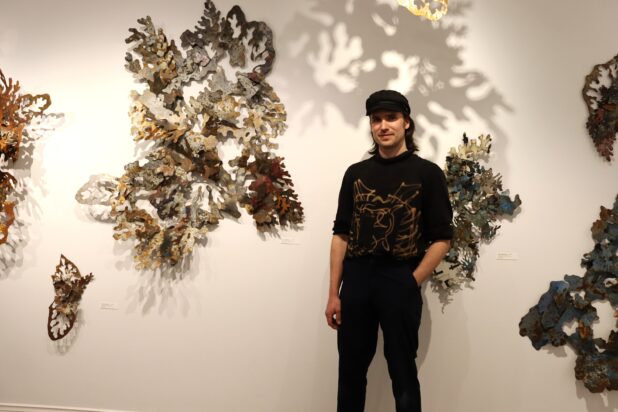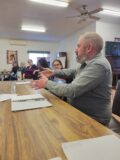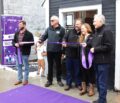Headline News
Garrett Gilbart’s Terra Precarium art opening a metallic art feast
April 15, 2025

By Mike Riley
Local Journalism Initiative Reporter
The Art Gallery of Bancroft had the grand opening of Garrett Gilbart’s show Terra Precarium on April 3. The show runs from April 1 to 26 and the gallery, located at 10 Flint Avenue, is open Tuesday to Sunday from 11 a.m. to 4 p.m. The show is sponsored by Pat Cooke in memory of Paul D. Cooke. For more information, go to www.artgalleryofbancroft.ca, 613-332-1542 or contact artist Molly Moldovan at [email protected]. Moldovan and Gilbart comment to Bancroft This Week about the show opening.
A professional sculptor from Douro, Ontario, Gilbart initially studied welding and fabrication at Sir Sanford Fleming College, received their BFA from NSCAD University in Halifax and studied at Amsterdam’s Gerrit Rietveld Academie. Gilbart explains that the steel sculptures he created for Terra Precarium draw an unexpected parallel to Bancroft’s mineral wealth, with their rusted surfaces and automotive pigments.
“Rust, a form of iron oxide, mirrors the earthly reds and ochres found in iron-rich stone, reinforcing the notion that these pieces are geological in nature, mimicking not only lichen but also the mineral processes unfolding beneath our feet. By positioning steel, an industrial material forged from mined iron, alongside forms inspired by lichen, the work reflects the uneasy intersection of extraction, industry, and ecology.”
Gilbart describes themselves as a carver of unnatural materials.
“Instead of wood and stone, I intricately carve discarded tools, car parts and other salvaged industrial steel objects collected from the forests and scrapyards of rural Ontario” they say.
Gilbart says the art they create is typically done with a handheld plasma cutter, which is a welding torch used for melting and cutting steel that would typically be integrated into a computer-controlled table. However, by using a torch freehand, they expand the flexibility and possibilities of the tool.
In their artist statement, Gilbart explains that the body of work in Terra Precarium interrogates the complex entanglement between industrial and environmental processes through organic forms, exploring steel as a base for evoking the delicate yet persistent structures of lichen, coral and other biomorphic growths.
“By employing hand-carved plasma cutting and layered automotive pigments, I embrace the tension between industrial decay and natural resilience, revealing how material processes inscribe themselves into both environmental and social narratives,” they say.
Gilbart explains that their sculptures take inspiration from lichen, a composite organism that thrives in liminal space—a symbiotic entanglement of fungi and algae that exists between worlds, neither fully plant nor fungus but the relationship between the two. As a bio-indicator, lichen’s capacity to extract nutrients from the air makes it acutely responsive to environmental change, mapping the shifts of industrial pollution and climate change across its fragile structures.
“My interest in lichen began during an Arctic residency in eastern Iceland, where I observed its capacity to colonize barren landscapes, covering rusting steel elements of the abandoned fish factory we were working out of, quietly asserting itself against inhospitable conditions. Informed by this resilience, my sculptures mimic lichen’s intricate growth patterns while alluding to the broader human and geological forces that shape planetary processes. These forms simultaneously recall the shifting topographies of tectonic plates and the minute fractal structures found in microcellular life, underscoring the collapse of distinctions between the macro and micro in an era of climate crisis. By privileging hand-carving over CNC automation, my work resists the sterility of digital precision, foregrounding the haptic labor and improvisational potential inherent in manual craft processes. This decision speaks to the erosion of the proletariat in the 21st century and reflects my ongoing engagement with the precarity of industrial craftsmanship and labour. Plasma cutting by hand invites a performative element to the creation process, recalling the intuitive gestures of drawing while invoking the corporeal memory embedded in traditional carving practices, instead of wood and stone, I carve the unnatural resources of the past sourced from the scrapyard instead of the marble quarry. This tactile approach positions the sculptures as artifacts of embodied labor, simultaneously fragile and resilient,” they say.
On the evening of the art opening on April 3, attendees were very impressed with Gilbart’s work. In addition to showing their work, they also played some hauntingly beautiful music on one of their art pieces, even using a metal detector to evoke musical noises from the pieces hanging on the gallery walls, to the audience’s collective amazement and applause. Gilbart says that sound is a critical element in this body of work.
“Through the integration of contact microphones, synthesizers, and a modified metal detector and theremin, the sculptures are transformed into resonant instruments. Subtle movements and shifts alter the sonic landscape through the vibrations of the material that echo seismic activity, electromagnetic interference, or the aesthetic experience of the crunch of lichen beneath the foot. These auditory layers evoke the unseen forces that shape both natural and industrial environments, reinforcing the idea that materiality is never static but in constant negotiation with its surroundings,” they say.
Mandy Armstrong thought Gilbart’s exhibit was beautiful.
“I love how the shadow falls on the wall, almost makes it like another part of the art but the shadow behind it. It’s different from far and up close. There’s so much going on. The different colours and textures and everything and the shapes they cut,” she says.
Gilbart told Bancroft This Week that they were surprised by the turnout on April 3.
“So many people had thoughtful questions and really good feedback. In the future, I want to do more public galleries and artist run centres and this is a really good step towards that,” they say.
Moldovan told Bancroft This Week on April 4 that she thought the opening of Terra Precarium was equal parts fun and amazing.
“We were a small crowd of 25, and everyone there seemed absolutely blown away by the work and the musical performance. The artist refers to it as “music adjacent” but I can easily imagine him creating the score for a sci fi film with those sounds. Garrett’s work is a delightful study in contradictions – it creates an immersive feeling of nature, warm and alive – in the gallery, in spite of being crafted of industrial metals,” she says. “One of the pieces sold at the reception and another sold this afternoon, a lovely affirmation that Garrett’s art resonates with a wider audience!”


















